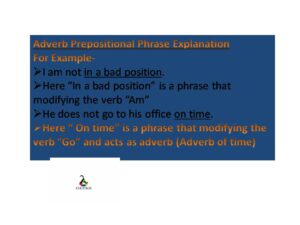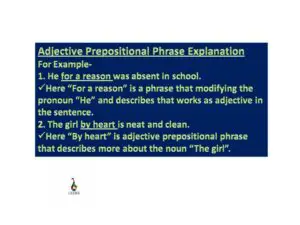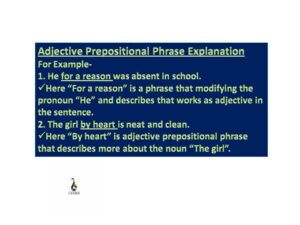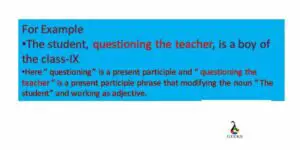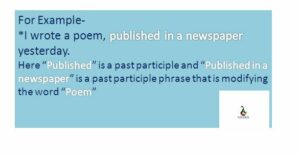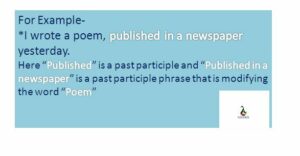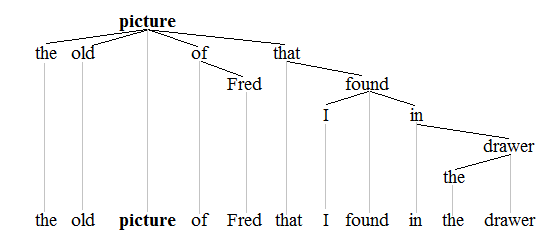An adverb prepositional phrase is a group of words that functions as an adverb in a sentence. It consists of a preposition, followed by a noun or pronoun, and any modifiers. Adverb prepositional phrases provide additional information about the verb, adjective, or adverb in a sentence, answering questions such as how, when, where, or why. They add depth and specificity to the sentence, helping to paint a clearer picture for the reader. In this article, we will explore various examples of adverb prepositional phrases and how they can be used to enhance your writing. So, let’s dive in and discover the versatility and power of adverb prepositional phrases!
Key Takeaways
- Adverb prepositional phrases modify verbs, adjectives, or other adverbs.
- They consist of a preposition followed by a noun or pronoun.
- Examples of adverb prepositional phrases include “in the morning,” “on the table,” and “with great care.”
- Adverb prepositional phrases provide additional information about time, location, manner, or condition.
- They can be used to add detail and specificity to a sentence.
Adjective Prepositional Phrase Examples
Definition of Adjective Prepositional Phrase
An adjective prepositional phrase is a group of words that includes an adjective and a preposition, along with any other words that complete the phrase. This type of phrase functions as an adjective, modifying a noun or pronoun in a sentence. It provides additional information about the noun or pronoun by answering questions such as “which one?” or “what kind?”.
In an adjective prepositional phrase, the adjective is the main word that describes or qualifies the noun or pronoun, while the preposition shows the relationship between the adjective and the rest of the sentence. The other words in the phrase, if any, serve to complete the meaning of the phrase.
Examples of Adjective Prepositional Phrases
Here are some examples of adjective prepositional phrases in sentences:
- The book on the shelf is mine.
-
In this sentence, the adjective prepositional phrase is “on the shelf.” The adjective “on” describes the noun “book,” and the preposition “on” shows the relationship between the book and the shelf.
-
The girl with the red hair is my sister.
-
In this sentence, the adjective prepositional phrase is “with the red hair.” The adjective “red” describes the noun “hair,” and the preposition “with” shows the relationship between the girl and her red hair.
-
The house by the lake has a beautiful view.
-
In this sentence, the adjective prepositional phrase is “by the lake.” The adjective “by” describes the noun “house,” and the preposition “by” shows the relationship between the house and the lake.
-
The man in the blue shirt is the teacher.
-
In this sentence, the adjective prepositional phrase is “in the blue shirt.” The adjective “blue” describes the noun “shirt,” and the preposition “in” shows the relationship between the man and his blue shirt.
-
The car without a roof is a convertible.
-
In this sentence, the adjective prepositional phrase is “without a roof.” The adjective “without” describes the noun “car,” and the preposition “without” shows the relationship between the car and its missing roof.
-
The dog under the table is hiding.
- In this sentence, the adjective prepositional phrase is “under the table.” The adjective “under” describes the noun “dog,” and the preposition “under” shows the relationship between the dog and the table.
Adjective prepositional phrases can add descriptive details to a sentence, making it more interesting and informative. By understanding how to use them correctly, you can enhance your writing and communication skills.
Adverb Prepositional Phrase Examples
Definition of Adverb Prepositional Phrase
An adverb prepositional phrase is a group of words that functions as an adverb in a sentence. It consists of a preposition, followed by a noun or pronoun, and any modifiers. Adverb prepositional phrases provide additional information about how, when, where, or why an action occurs. They add detail and specificity to a sentence, allowing the reader to better understand the circumstances surrounding an event or action.
Examples of Adverb Prepositional Phrases
Adverb prepositional phrases can be used to modify verbs, adjectives, or other adverbs. Let’s explore some examples to understand how they work:
-
Modifying Verbs:
-
She ran through the park to catch the bus.
- He studied for hours to prepare for the exam.
- They celebrated with great enthusiasm after winning the game.
In these examples, the adverb prepositional phrases “through the park,” “for hours,” and “with great enthusiasm” provide additional information about how the actions of running, studying, and celebrating took place.
-
Modifying Adjectives:
-
The cake was of exceptional quality.
- She was incredibly happy with her new job.
- He felt extremely tired after the long journey.
Here, the adverb prepositional phrases “of exceptional quality,” “incredibly happy,” and “extremely tired” modify the adjectives “exceptional,” “happy,” and “tired,” respectively. They describe the degree or intensity of the adjective.
-
Modifying Adverbs:
-
He spoke very softly during the meeting.
- She ran quite quickly to catch the train.
- They played too aggressively during the game.
In these examples, the adverb prepositional phrases “very softly,” “quite quickly,” and “too aggressively” modify the adverbs “softly,” “quickly,” and “aggressively,” respectively. They provide additional information about the manner or intensity of the action.
It’s important to note that adverb prepositional phrases can be placed at the beginning, middle, or end of a sentence, depending on the desired emphasis or clarity. They enhance the meaning of a sentence by providing specific details about the action, time, place, or manner in which something occurs.
Adverbial Prepositional Phrase Definition
An adverbial prepositional phrase is a group of words that functions as an adverb in a sentence. It consists of a preposition, which is a word that shows the relationship between a noun or pronoun and another word in the sentence, and an object of the preposition, which is the noun or pronoun that follows the preposition. Together, they form a phrase that modifies a verb, adjective, or adverb.
Adverbial prepositional phrases provide additional information about when, where, why, or how an action takes place. They add detail and specificity to a sentence, helping to paint a clearer picture for the reader. Let’s explore some examples to better understand how adverbial prepositional phrases work.
Explanation of Adverbial Prepositional Phrase
To understand adverbial prepositional phrases, let’s break down their components and see how they function in sentences.
Preposition: A preposition is a word that shows the relationship between a noun or pronoun and another word in the sentence. Common prepositions include “in,” “on,” “at,” “under,” “over,” “through,” and “with.” For example, in the sentence “She sat on the chair,” the word “on” is the preposition.
Object of the Preposition: The object of the preposition is the noun or pronoun that follows the preposition. It provides more information about the relationship between the preposition and the rest of the sentence. In the previous example, the object of the preposition is “the chair.”
Adverbial Function: When a prepositional phrase modifies a verb, adjective, or adverb, it functions as an adverbial phrase. It adds information about when, where, why, or how an action takes place. For example, in the sentence “She sat on the chair,” the prepositional phrase “on the chair” answers the question “where” and modifies the verb “sat.”
Adverbial prepositional phrases can appear at the beginning, middle, or end of a sentence. They can also be single-word phrases or longer phrases consisting of multiple words. Let’s look at some examples to see how adverbial prepositional phrases are used in sentences.
Examples of Adverbial Prepositional Phrases
Here are some examples of adverbial prepositional phrases in sentences:
- At the park, children were playing on the swings. (Answers the question “where”)
- She arrived after the concert ended. (Answers the question “when”)
- He ran through the forest to escape the storm. (Answers the question “where”)
- They went to the store with their friends. (Answers the question “with whom”)
- In the morning, I like to drink a cup of coffee. (Answers the question “when”)
As you can see, adverbial prepositional phrases provide additional information that helps to clarify the context or circumstances of an action. They enhance the meaning of a sentence by specifying details such as time, place, manner, or condition.
It’s important to note that adverbial prepositional phrases can be moved within a sentence without changing the overall meaning. For example, in the sentence “She sat on the chair,” the adverbial prepositional phrase “on the chair” can be moved to the beginning of the sentence: “On the chair, she sat.” Both versions convey the same information.
Adjective Prepositional Phrase Definition
An adjective prepositional phrase is a group of words that functions as an adjective in a sentence. It consists of a preposition, its object, and any modifiers that may accompany the object. Adjective prepositional phrases provide additional information about a noun or pronoun, describing or modifying it in some way.
Explanation of Adjective Prepositional Phrase
An adjective prepositional phrase begins with a preposition, such as “in,” “on,” “at,” “under,” or “between.” This preposition is followed by a noun or pronoun, which is the object of the preposition. Together, the preposition and its object form the core of the phrase.
To further modify the object, additional words can be included in the phrase. These modifiers can be adjectives, adverbs, or even other prepositional phrases. The purpose of these modifiers is to provide more specific details or clarify the meaning of the object.
Let’s look at an example to better understand how adjective prepositional phrases work:
Example: The book on the shelf is mine.
In this sentence, the adjective prepositional phrase is “on the shelf.” The preposition is “on,” and its object is “the shelf.” The phrase modifies the noun “book” by specifying its location. It tells us that the book is on the shelf.
Adjective prepositional phrases can be used to provide information about time, place, manner, condition, or purpose. They add depth and specificity to sentences, allowing writers to paint a clearer picture for their readers.
Here are some more examples of adjective prepositional phrases:
- The girl with the red hair is my best friend.
- The car in the garage needs repairs.
- The dog under the table is begging for food.
- The house on the hill has a beautiful view.
- The man with the briefcase is the CEO.
As you can see, these phrases provide additional details about the nouns they modify, giving the reader a better understanding of the subject.
Using adjective prepositional phrases in your writing can make it more descriptive and engaging. By incorporating these phrases, you can add depth and specificity to your sentences, making them more interesting to read. So, next time you’re writing, consider using adjective prepositional phrases to enhance your descriptions and bring your writing to life.
Adjective Prepositional Phrase Exercises
Practice exercises for identifying and using adjective prepositional phrases
Adjective prepositional phrases are groups of words that modify nouns or pronouns by providing additional information about them. These phrases consist of a preposition, its object, and any modifiers that come after it. Adjective prepositional phrases can be used to add descriptive details to a sentence and make it more interesting. Let’s practice identifying and using adjective prepositional phrases with the following exercises:
- Identifying Adjective Prepositional Phrases
In this exercise, you will identify the adjective prepositional phrases in the given sentences. Remember, an adjective prepositional phrase modifies a noun or pronoun.
Example: The book on the shelf is mine.
- Adjective prepositional phrase: on the shelf
Now, it’s your turn. Identify the adjective prepositional phrases in the following sentences:
- The girl with the red hair is my best friend.
- The house near the river is for sale.
- The dog in the backyard is barking loudly.
- The car with the broken windshield needs repairs.
- The man in the blue suit is the CEO.
Take your time and analyze each sentence carefully. Once you have identified the adjective prepositional phrases, move on to the next exercise.
- Using Adjective Prepositional Phrases
Now that you have practiced identifying adjective prepositional phrases, let’s move on to using them in sentences. In this exercise, you will create your own sentences using adjective prepositional phrases.
Choose a noun or pronoun as the subject of your sentence, and then add an adjective prepositional phrase to provide more information about it. Be creative and try to make your sentences as descriptive as possible.
Example: The cat on the roof is afraid of heights.
Here are a few more examples to inspire you:
- The student with the backpack is running late for class.
- The flowers in the garden are blooming beautifully.
- The house on the hill has a stunning view.
- The cake with the chocolate frosting is delicious.
- The girl in the red dress is dancing gracefully.
Feel free to come up with your own sentences and experiment with different adjective prepositional phrases. This exercise will help you become more comfortable using these phrases in your writing.
- Identifying and Using Adjective Prepositional Phrases in Context
In this exercise, you will read a short paragraph and identify the adjective prepositional phrases. After identifying them, rewrite the paragraph by adding or modifying adjective prepositional phrases to enhance the description.
Example:
Original paragraph: The house is old.
Revised paragraph: The house with the creaky wooden floors and peeling paint is old.
Now, read the following paragraph and complete the exercise:
“The park is beautiful. It has a large lake. There are trees around the lake. People often go there for picnics.”
Take a moment to identify the adjective prepositional phrases in the original paragraph. Then, rewrite the paragraph by adding or modifying adjective prepositional phrases to make it more descriptive.
Remember to use your creativity and imagination to enhance the description of the park. Once you have completed this exercise, you will have a better understanding of how adjective prepositional phrases can be used to add detail and depth to your writing.
Frequently Asked Questions
Q: What is a prepositional phrase? Can you give 5 examples?
A: A prepositional phrase is a group of words that begins with a preposition and ends with a noun or pronoun. Here are 5 examples of prepositional phrases:
– In the park: We played soccer in the park.
– On the table: The book is on the table.
– Under the bridge: The cat hid under the bridge.
– With a smile: She greeted me with a smile.
– By the river: We enjoyed a picnic by the river.
Q: Can you provide examples of adjective prepositional phrases?
A: Certainly! Here are a few examples of adjective prepositional phrases:
– Full of energy: The children were full of energy.
– Proud of his achievement: He was proud of his achievement.
– Afraid of heights: She is afraid of heights.
– Interested in art: He is interested in art.
– Happy with the result: We were happy with the result.
Q: What questions do adverb prepositional phrases answer?
A: Adverb prepositional phrases answer questions such as:
– When?: She arrived after the party.
– Where?: He went to the store.
– How?: They ran with great speed.
– Why?: She left due to the bad weather.
– To what extent?: He studied for hours.
Q: What is an adjective prepositional phrase? Can you provide examples?
A: An adjective prepositional phrase is a group of words that starts with a preposition and describes a noun or pronoun. Here are some examples:
– In a hurry: The man walked in a hurry.
– With a broken leg: She hopped on one foot with a broken leg.
– Like a professional: He played the guitar like a professional.
– Without any hesitation: She answered without any hesitation.
– In a state of confusion: They looked at each other in a state of confusion.
Q: Can you give examples of adverb prepositional phrases?
A: Certainly! Here are a few examples of adverb prepositional phrases:
– In the morning: I go for a jog in the morning.
– With great care: She handled the fragile vase with great care.
– By bus: They traveled to the city by bus.
– In a hurry: He finished his work in a hurry.
– With a smile: She greeted him with a smile.
Q: What is the definition of an adverbial prepositional phrase?
A: An adverbial prepositional phrase is a group of words that functions as an adverb and begins with a preposition. It provides additional information about the verb, adjective, or adverb in a sentence.
Q: What is the definition of an adjective prepositional phrase?
A: An adjective prepositional phrase is a group of words that functions as an adjective and begins with a preposition. It describes or modifies a noun or pronoun in a sentence.
Q: What is an adverb prepositional phrase?
A: An adverb prepositional phrase is a group of words that functions as an adverb and begins with a preposition. It provides additional information about the verb, adjective, or adverb in a sentence.
Q: Can you provide examples of adverbial prepositional phrases?
A: Certainly! Here are a few examples of adverbial prepositional phrases:
– In the morning: I go for a walk in the morning.
– With great enthusiasm: She sang with great enthusiasm.
– By car: They traveled to the beach by car.
– In a hurry: He finished his homework in a hurry.
– With caution: The driver approached the intersection with caution.
Q: Are there any exercises for practicing adjective prepositional phrases?
A: Yes, here’s an exercise to practice identifying and using adjective prepositional phrases:
– Rewrite the following sentence, adding an adjective prepositional phrase: “He sat on the chair.”
– Answer: “He sat on the chair with a cushion.”
Remember to use your creativity and apply appropriate prepositions to modify the noun or pronoun in the sentence.
